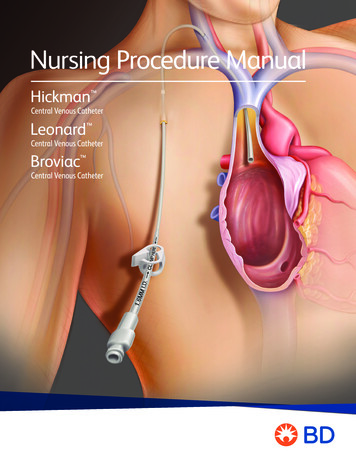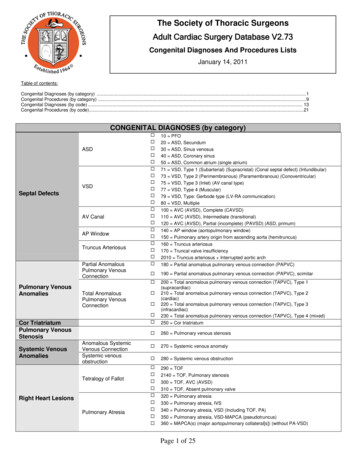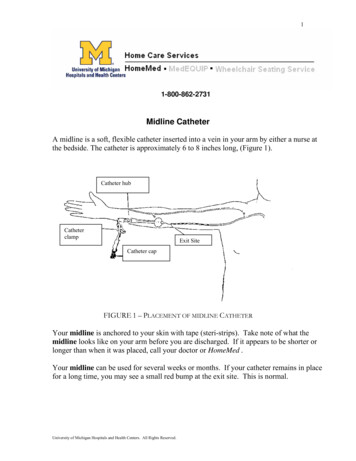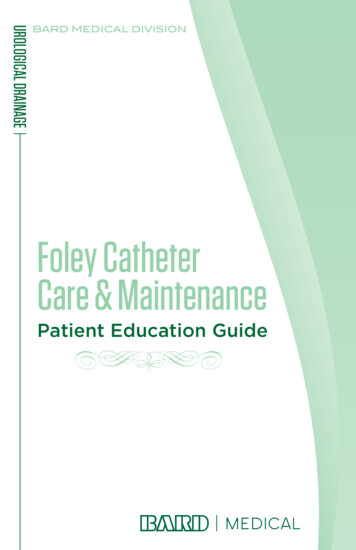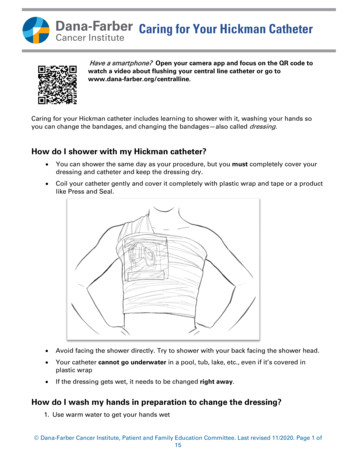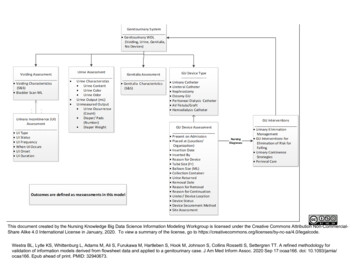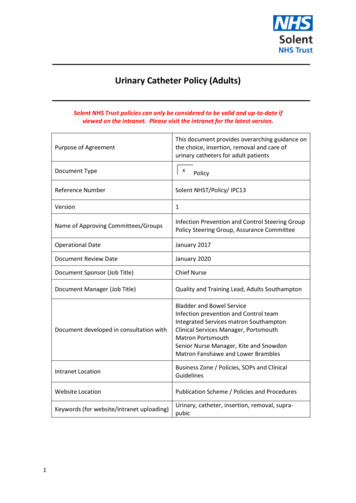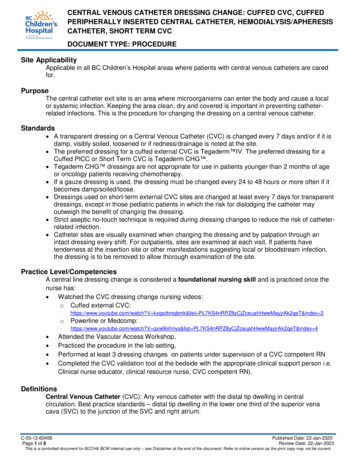
Transcription
CENTRAL VENOUS CATHETER DRESSING CHANGE: CUFFED CVC, CUFFEDPERIPHERALLY INSERTED CENTRAL CATHETER, HEMODIALYSIS/APHERESISCATHETER, SHORT TERM CVCDOCUMENT TYPE: PROCEDURESite ApplicabilityApplicable in all BC Children’s Hospital areas where patients with central venous catheters are caredfor.PurposeThe central catheter exit site is an area where microorganisms can enter the body and cause a localor systemic infection. Keeping the area clean, dry and covered is important in preventing catheterrelated infections. This is the procedure for changing the dressing on a central venous catheter.Standards A transparent dressing on a Central Venous Catheter (CVC) is changed every 7 days and/or if it isdamp, visibly soiled, loosened or if redness/drainage is noted at the site. The preferred dressing for a cuffed external CVC is Tegaderm IV. The preferred dressing for aCuffed PICC or Short Term CVC is Tegaderm CHG . Tegaderm CHG dressings are not appropriate for use in patients younger than 2 months of ageor oncology patients receiving chemotherapy. If a gauze dressing is used, the dressing must be changed every 24 to 48 hours or more often if itbecomes damp/soiled/loose. Dressings used on short-term external CVC sites are changed at least every 7 days for transparentdressings, except in those pediatric patients in which the risk for dislodging the catheter mayoutweigh the benefit of changing the dressing. Strict aseptic no-touch technique is required during dressing changes to reduce the risk of catheterrelated infection. Catheter sites are visually examined when changing the dressing and by palpation through anintact dressing every shift. For outpatients, sites are examined at each visit. If patients havetenderness at the insertion site or other manifestations suggesting local or bloodstream infection,the dressing is to be removed to allow thorough examination of the site.Practice Level/CompetenciesA central line dressing change is considered a foundational nursing skill and is practiced once thenurse has: Watched the CVC dressing change nursing videos:o Cuffed external CVC:https://www.youtube.com/watch?V kxqsdtmqbmk&list PL7KS4nRPZ8yCjZceuahHwwMayjrAk2qeT&index 3oPowerline or Medcomp:https://www.youtube.com/watch?V qxw9iiihnys&list PL7KS4nRPZ8yCjZceuahHwwMayjrAk2qeT&index 4 Attended the Vascular Access Workshop,Practiced the procedure in the lab setting,Performed at least 3 dressing changes on patients under supervision of a CVC competent RNCompleted the CVC validation tool at the bedside with the appropriate clinical support person i.e.Clinical nurse educator, clinical resource nurse, CVC competent RN).DefinitionsCentral Venous Catheter (CVC): Any venous catheter with the distal tip dwelling in centralcirculation. Best practice standards – distal tip dwelling in the lower one third of the superior venacava (SVC) to the junction of the SVC and right atrium.C-05-12-60458Page 1 of 6Published Date: 22-Jan-2020Review Date: 22-Jan-2023This is a controlled document for BCCH& BCW internal use only – see Disclaimer at the end of the document. Refer to online version as the print copy may not be current.
CENTRAL VENOUS CATHETER DRESSING CHANGE: CUFFED CVC, CUFFEDPERIPHERALLY INSERTED CENTRAL CATHETER, HEMODIALYSIS/APHERESISCATHETER, SHORT TERM CVCDOCUMENT TYPE: PROCEDUREAseptic no-touch technique (ANTT): a standardized technique that is used during clinicalprocedures to identify and prevent microbial contamination of aseptic key parts and key sites byensuring that they are not touched either directly or indirectly. A ‘key part’ is the part of the equipmentthat must remain sterile and must only contact other key parts or key sites. Or it is the area on thepatient such as a wound, or IV insertion site that must be protected from microorganisms. Aseptic keyparts can only contact other aseptic key parts/sites. If it is necessary to touch key parts/sites, sterilegloves are to be worn to ensure asepsis is maintained.Equipment Hospital grade surface disinfectant wipe (e.g. Caviwipe )MaskGloves, non-sterileDressing traySterile gloves3 x 2% chlorhexidine with 70% alcohol swabs2 x 2% Chlorhexidine with/without 70% alcohol impregnated swab stickSterile cotton tipped applicators (as needed to remove excess drainage/crusting)Sterile water if needed to remove excess drainage/crustingAdhesive remover as requiredCavilon no sting barrier (optional) – note that oncology patients use the sterile Cavilon no stingbarrier swab sticks. The spray should not be used as it is not sterile. Sterile transparent wound dressing (Tegaderm CHG for short term CVC and cuffed PICC,Tegaderm or IV 3000 for long-term cuffed CVC) or sterile gauze dressing if patient is unable totolerate a transparent dressing (due to allergy, sensitive skin or skin reaction). See Management ofDressing Related Dermatitis algorithm. Securement device (i.e. Statlock ) or waterproof tape and pin as requiredProcedureStepsRationale1. IDENTIFY patient and EXPLAIN procedure.Failure to correctly identify patients prior toprocedures may result in errors.Reduces child and caregiver’s anxiety. Evaluatesand reinforces understanding of previously taughtinformation and confirms consent process.Facilitates completion of task in a timely mannerRoutine infection control practices; reducestransmission of microorganisms.2. ASSEMBLE supplies.3. CLEAN working surface using hospital grade surfacedisinfectant wipe (e.g. Caviwipe ) and let dry forrecommended contact time.4. ASSESS exit site for redness, swelling, tenderness, ordrainage. Prepare supplies to CULTURE significantdrainage and NOTIFY physician. Refer to the eLabhandbook for wound culture instructions. For alternatedressing options refer to Management of DressingRelated Dermatitis Algorithm-CV.04.05A5. DON mask. PERFORM hand hygiene as per infectioncontrol standards.6. PREPARE equipment using aseptic no-touchtechnique at beside.7. PERFORM hand hygiene as per infection controlstandards.C-05-12-60458Page 2 of 6Assessing the entry site for inflammation willprevent unnecessary delays in providingappropriate interventions in care of the patient.Routine infection control practices; reducestransmission of microorganisms.Published Date: 22-Jan-2020Review Date: 22-Jan-2023This is a controlled document for BCCH& BCW internal use only – see Disclaimer at the end of the document. Refer to online version as the print copy may not be current.
CENTRAL VENOUS CATHETER DRESSING CHANGE: CUFFED CVC, CUFFEDPERIPHERALLY INSERTED CENTRAL CATHETER, HEMODIALYSIS/APHERESISCATHETER, SHORT TERM CVCDOCUMENT TYPE: PROCEDURE8. DON clean gloves. REMOVE old dressing andDISCARD. REMOVE securement device/waterprooftape if present. May use adhesive remover if patientrequests.9. REMOVE gloves and PERFORM hand hygiene. DONsterile gloves. If using a Stat-Lock, open and close thewings several times in preparation for securement.10. LIFT catheter off skin with sterile gauze. With firstchlorhexidine/alcohol swab, CLEAN the catheter awayfrom the exit site using friction. Repeat at least oncemore until catheter is visibly clean. Continue to HOLDcatheter with sterile gauze lifted off skin and allow todry for one minute.11. In your mind, DIVIDE the area of skin that will beunder the dressing into 2 halves. With the first swabstick CLEAN skin horizontally away from the exit siteusing a back-and-forth motion with light friction for 15seconds. FLIP the swab stick and CLEAN the secondhalf horizontally away from the exit site using a backand-forth motion with light friction for another 15seconds. Discard swab stick.12. REPEAT step 11 with the second swab stick, cleaningvertically away for the exit site using friction for 15seconds. FLIP the swab stick and CLEAN the secondhalf vertically away from the exit site using a back-andforth motion with light friction for another 15 seconds.Discard swab stick.NOTE: Excess drainage or crusting can be removedwith cotton tipped applicator soaked with sterile waterif needed.C-05-12-60458Page 3 of 6Routine infection control practices; reducestransmission of microorganisms.This action promotes binding of the chlorhexidineto the layers of skin and improves efficacy.Flipping the swab stick allows for maximumdispensing of antiseptic solution from the sponge.Do not use normal saline as chlorhexidine may beinactivated if in contact with normal saline.Published Date: 22-Jan-2020Review Date: 22-Jan-2023This is a controlled document for BCCH& BCW internal use only – see Disclaimer at the end of the document. Refer to online version as the print copy may not be current.
CENTRAL VENOUS CATHETER DRESSING CHANGE: CUFFED CVC, CUFFEDPERIPHERALLY INSERTED CENTRAL CATHETER, HEMODIALYSIS/APHERESISCATHETER, SHORT TERM CVCDOCUMENT TYPE: PROCEDURE13. ALLOW chlorhexidine/alcohol solution to air dry for atleast one minute and until visually dry or for threeminutes if using swab sticks without alcohol.14. APPLY Cavilon no sting barrier (if using) to skin thatwill be in contact with dressing adhesive only. AVOID1-2cm around exit site. Allow Cavilon no stingbarrier to dry for a minimum of 30 seconds.Provides time for optimal efficacy and decreasesrisk of skin irritation or burn.15. For cuffed CVCs and cuffed PICCs, COIL catheter asshown:Provides additional securement.16. APPLY appropriate securement device as appropriate(i.e. STAT lock). If no securement device requiredAPPLY appropriate dressing. ENSURE occlusive sealaround dressing and catheter. Do not stretchdressing over skin.17. SECURE catheter below dressing to patient's skin withsmall strips provided with dressing or, smalltransparent dressing. Use waterproof tape and safetypin to further secure catheter to patient’s clothing.18. REMOVE equipment and gloves and DISPOSEappropriately. PERFORM hand hygiene. REMOVEmask and PERFORM hand hygiene.Stretching the dressing may cause skin irritationand blistering.To prevent line from migrating, STAT lock may beused for hemodialysis/apheresis catheters orshort term CVCs as lines are unable to be coiled.Provides added securement.C-05-12-60458Page 4 of 6Protects skin and improves adherence.Routine infection control practices; reducestransmission of microorganismsPublished Date: 22-Jan-2020Review Date: 22-Jan-2023This is a controlled document for BCCH& BCW internal use only – see Disclaimer at the end of the document. Refer to online version as the print copy may not be current.
CENTRAL VENOUS CATHETER DRESSING CHANGE: CUFFED CVC, CUFFEDPERIPHERALLY INSERTED CENTRAL CATHETER, HEMODIALYSIS/APHERESISCATHETER, SHORT TERM CVCDOCUMENT TYPE: PROCEDUREDocumentationLABEL the dressing with the following information: date, time, and initial of the nurse performing thedressing change.DOCUMENT on appropriate record(s) (i.e. Central Venous Line Flowsheet for all routine procedures): date dressing used (if patient uses dressing other than Tegaderm) cleaning solution used (if patient uses alcohol free swab sticks) assessment of site and surrounding skin if unusual patient's response to procedure if unusual unexpected outcomes and related treatment any other actions or observationsReferencesBoyce, J.M. and Pittet, D. Healthcare Infection Control Practices Advisory Committee and theHICPAC/SHEA/APIC/IDSA Hand Hygiene Task Force. Guideline for hand hygiene in health-caresettings. MMWR Morbid Mortal Wkly Rep. 2002; 51: 1–45Infusion Nurses Society (INS) (2016) Infusion therapy standards of practice. Standard 33: Vascular access sitepreparation and device placement. Journal of Nursing, 39(Suppl. 1) S64-S67 (Level VII)Infusion Nurses Society (INS) (2016) Infusion therapy standards of practice. Standard 41: Vascular accessdevice (VAD) assessment, care, and dressing changes. Journal of Nursing, 39(Suppl. 1) S81-S83(Level VII)Marschall, J, Mermel, LA, Fakih M, et al (2014) Strategies to prevent central line-associated bloodstreaminfections in acute care hospital: 2014 update. Infection Control and Hospital Epidemiology, 35 (7) 754771O’Grady, N.P., Alexander, M., Burns, L.A., Dellinger E.P., Garland, J., Heard, S.O., Lipsett, P.A., Masur, H.,Mermel, L.A., Pearson, M.L., Raad, I.I., Randolph, A., Rupp, M.E., Saint, S. and the Healthcare InfectionControl Practices Advisory Committee (HICPAC). (2011). Guidelines for the prevention of intravascularcatheter-related infections, 2011. Centers of Disease Control and Prevention. Retrieved Dec 19 2019from s/bsi-guidelines-H.pdfRegistered Nurses’ Association of Ontario. (2008). Best Practice Guideline: Care and Maintenance to ReduceVascular Access Complications. Retrieved December 19, 2019 from https://rnao.ca/sites/rnaoca/files/Care and Maintenance to Reduce Vascular Access Complications.pdf.Safer Healthcare Now. (2012). Getting started kit: Prevent Central Line Infections. Retrieved December 19,2019 0Started%20Kit.pdfSoluPrep Swabs and Wipes Instructions for Use. (2013). 3M Infection Prevention Solutions.World Health Organization. (2009) WHO guidelines on hand hygiene in health care Retrieved December 192019 from 597906 eng.pdfC-05-12-60458Page 5 of 6Published Date: 22-Jan-2020Review Date: 22-Jan-2023This is a controlled document for BCCH& BCW internal use only – see Disclaimer at the end of the document. Refer to online version as the print copy may not be current.
CENTRAL VENOUS CATHETER DRESSING CHANGE: CUFFED CVC, CUFFEDPERIPHERALLY INSERTED CENTRAL CATHETER, HEMODIALYSIS/APHERESISCATHETER, SHORT TERM CVCDOCUMENT TYPE: PROCEDUREDeveloped ByBCCH Hematology/Oncology – Clinical Nurse EducatorVersion HistoryDATE03-Oct-201818-Dec-2019DOCUMENT NUMBER and TITLECV.03.15 Central Venous Line Dressing Change: CuffedCentral Venous Catheter, Cuffed Peripherally InsertedCentral Catheter, Hemodialysis/Apheresis Catheter, ShortTerm CvcC-05-12-60458 Central Venous Catheter DressingChange: Cuffed CVC, Cuffed Peripherally Inserted CentralCatheter, Hemodialysis/Apheresis Catheter, Short TermCVCACTION TAKENApproved at: BCCH Best Practice CommitteeApproved at: C&W Best Practice CommitteeDisclaimerThis document is intended for use within BC Children’s and BC Women’s Hospitals only. Any other use or reliance is atyour sole risk. The content does not constitute and is not in substitution of professional medical advice. Provincial HealthServices Authority (PHSA) assumes no liability arising from use or reliance on this document. This document is protectedby copyright and may only be reprinted in whole or in part with the prior written approval of PHSA.C-05-12-60458Page 6 of 6Published Date: 22-Jan-2020Review Date: 22-Jan-2023This is a controlled document for BCCH& BCW internal use only – see Disclaimer at the end of the document. Refer to online version as the print copy may not be current.
chlorhexidine/alcohol swab, CLEAN the catheter away from the exit site using friction. Repeat at least once more until catheter is visibly clean. Continue to HOLD catheter with sterile gauze lifted off skin and allow to dry for one minute. 11. In your mind, DIVIDE the area of skin that will be under the dressing into 2 halves. With the first swab
